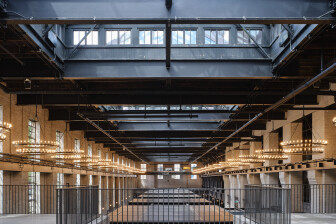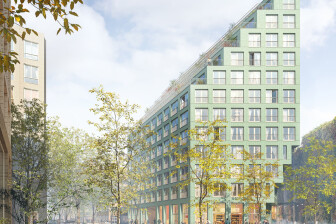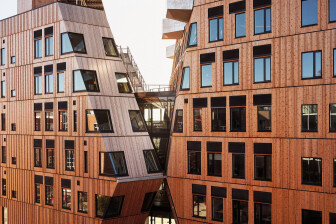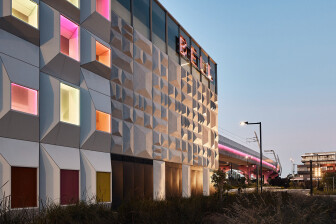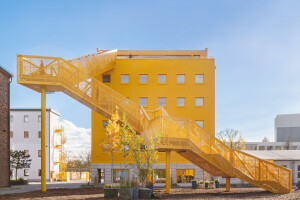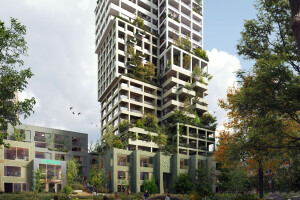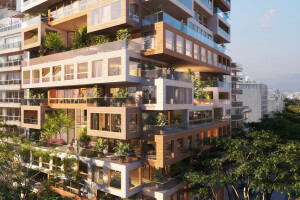ReviveR is a new exhibition by the international architectural firm MVRDV that explores Shenzhen Women & Children’s Centre as a circular manifesto for a low-carbon, child-friendly city. The exhibition takes place at the Shenzhen Women & Children’s Centre, a recently transformed tower building in the southern Chinese city’s Futian District. An educational endeavor, ReviveR considers a number of narratives that surround the building, from the importance of social and interactive environments for adults and children alike to the significance of the adaptive reuse of buildings as a way of reducing carbon emissions, following the principles of circularity.
MVRDV completed the transformation of Shenzhen Women & Children’s Centre in June 2023. The tower was originally built in 1994 and was part of Shenzhen’s first period of mass urban growth. “The building was beset by problems caused by its rushed design and construction,” says the studio. “Due to persistent fire safety concerns, the commercial units in the plinth were not opened until 2002 and the tower itself remained empty indefinitely.” The world’s largest emitter of CO2, China is committed to achieving peak carbon emissions by 2030 and carbon neutrality by 2060. As part of the country’s efforts to reach these goals, China is considering options for the reuse of buildings. The new Shenzhen Women & Children’s Centre was selected as one of 24 model examples by the National Development and Reform Commission.
Before:
After:
Renovating the 100-meter-tall (328 feet) tower, as opposed to demolishing and replacing it, allowed MVRDV to save 24,000 cubic meters of concrete: this translates to “a carbon saving equivalent to 11,800 flights from Amsterdam to Shenzhen,” says the studio. The building’s design transformation includes a number of elements: A new facade with a grid of multi-colored frames that increase its depth by one meter (approx. 3.3 feet) — these frames provide additional shade, helping to reduce thermal heat gain, and openable panels improve natural ventilation. The facade’s colors (yellow, orange, pink, and green) are a way of communicating the building’s layout — the brightly colored plinth is a service center for mothers and children, while the tower plays host to a hotel, where the facade's colors give way to white. A new “tower crown” provides cover and shade for a large terrace with views across the city. A courtyard, originally a car park, is now a colorful public space and food court. An entrance to the city’s metro was relocated inside the building, improving its connection with the transit network and encouraging a move away from car use.
MVRDV’s ReviveR exhibition asks: “What would our cities look like if we pursued similarly playful, social, and sustainable transformations of all existing buildings?” The exhibition “positions the Shenzhen Women & Children’s Centre as a kind of manifesto,” says the studio. It examines 27 MVRDV projects in three ways: those that transform existing buildings; those that “exemplify MVRDV’s bold and playful style”; and those that are in Southeast Asia. At the exhibition’s core, there are seven projects that represent all three areas, including the Shenzhen Women & Children’s Centre.
The design of the exhibition replicates the building’s colorful facade: yellow, orange, pink, and green. Circularity is explored as a recurring theme: “The curves and circles that characterize the building’s floor plans re-emerge in the layout of the exhibition, turning the three project categories into a Venn diagram with the core projects at the center,” says MVRDV. Circularity is also cleverly reflected in the exhibition’s palindromic name (reading the same backwards as forwards): ReviveR. The majority of materials that make up the exhibition are locally sourced and reusable, including bamboo structures that display the exhibits. When designing ReviveR, MVRDV was keen to ensure that children could interact with the exhibition: two worktables, for example, encourage kids to draw their city of the future and test their modeling skills with building blocks, building their city of the future. The studio’s aim is to inspire children, “the custodians of that future,” says MVRDV.
MVRDV founding partner Jacob van Rijs believes the Shenzhen Women & Children’s Centre could be a pioneering project for Shenzhen: “With the city’s fast-paced growth, many existing buildings were not really designed to have a long lifespan. That is a recipe for either an epidemic of demolition or, ideally, a great wave of adaptive reuse.”
ReviveR is at the Shenzhen Women & Children’s Centre until 28th February 2024.

























